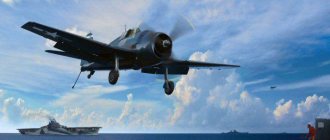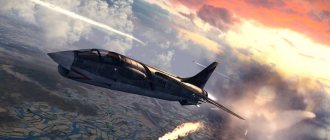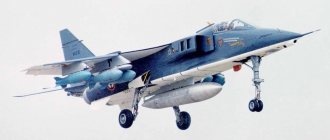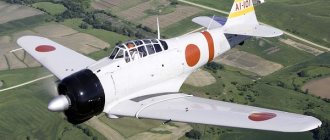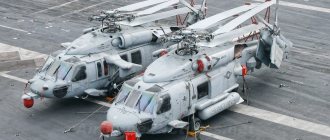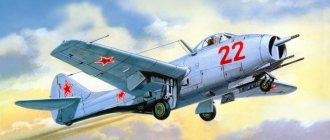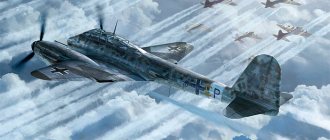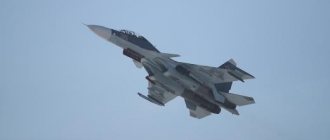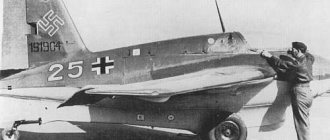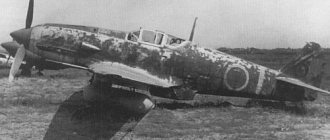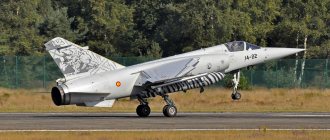By the mid-30s, the US economy was in a difficult situation caused by the Great Depression. Because of this, funding for the military industry, including aviation, has sharply decreased. The new aircraft models created were either built only in the form of prototypes or, at best, the matter was limited to a small series.
The aircraft with biplane wings that were in service with aircraft carriers were rapidly lagging behind the new developments of European companies. The US aviation industry needed a rapid breakthrough that would allow it to catch up with or even get ahead of its competitors. One of these designs was the Grumman F4F Wildcat carrier-based fighter, created in a short time.
Ugly kitten
The Grumman F4F-3 Wildcat fighter was a troubled aircraft from the very beginning of its career. Its flight performance characteristics (FTC), even in its original version, barely reached the technical specifications. And when 132 kilograms of armor and protected tanks were stuck into it, the performance characteristics of the vehicle became even less consistent with modern requirements.
Early Grumman F4F-3 Wildcat in pre-war livery (photo source)
Just before the war, a prototype XF4F-4 with folding planes was tested. This made it possible to significantly increase the number of fighters on aircraft carriers. At first, the folding units were equipped with a hydraulic drive, which increased the weight of the machine by another 136 kilos.
As a result, the takeoff weight exceeded 3.5 tons, and the flight characteristics sank even more. The pilots who tested the prototype recommended removing the mechanization and reducing the weight to at least 3.4 tons. They assessed this as the maximum at which the Wildcat resembled a fighter.
XF4F-4 prototype with hydraulic folding planes (photo source)
Their efforts were not in vain, and on production aircraft the planes were folded manually. However, in return, the native industry threw other dirty tricks at the pilots.
Coloring
Before painting, the model was coated with Tamiya primer poured from a can. After which the rivets were rolled using a homemade rivetter. After some polishing, the model was painted in “Light Gull Gray” FS 36440 (fuselage bottom) and “Blue Gray” FS 35189 (top). For painting, water-soluble paints “Akan” 72014 and 72050 were used (the latter color is very lightened). Slightly blurred borders of colors were obtained using plasticine “sausages”. Some inhomogeneity of color and uneven burnout was imitated by the Akanovsky finishing coating. Small paint chips were dry brushed with metallic paint from Model Master. After applying acrylic-urethane glossy varnish "Akan", decals were applied to the model using "special products" from MicroScale. After another layer of gloss varnish, the model was washed with oil paints on pinene. A semi-matte water-soluble varnish from MicroScale was used as a finishing coat. Finally, traces of use, leaks of technical fluids and carbon deposits were applied using Tamiya pigments. After the “painting work” was completed, the model was finally assembled, and antennas made from Hobby-plus thread and thin wire were installed. At this point, work on the model was completed, the result is in front of you, colleagues! Alexander Grishin
"More" does not mean "better"
“Wildcats” were also delivered to England, where they received the name “Martlet”. The British used these fighters primarily for air defense missions, so when ordering the second batch they wanted to bring them in line with their concept of machines of this class: “As many barrels as possible!”
Martlet MkII with British markings. Demonstration of the advantages of folding planes - three planes occupy the same area as one with folding planes (photo source)
Grumman met them halfway, and the next export model, in addition to folding wings, also received enhanced armament: two more were added to the four 12.7 mm machine guns. And in order not to make two types of planes - one for the allies, the other for themselves - the export model was actually imposed on the US Navy as the F4F-4.
Increasing the weight of the second salvo is a good thing. Although, as one American ace said: “If a pilot cannot hit with four guns, then at least give him ten…”. But in the case of the F4F-4, the installation of additional machine guns led to the fact that the ammunition load on the barrel dropped from 450 rounds (34 seconds of fire) to 240 (18 seconds).
F4F-4 Wildcat with open hatches for charging and servicing its six machine guns (photo source)
Using the Wildcat as an air defense fighter, as the British used the aircraft, did not cause any particular problems due to the reduction in ammunition - the F4F-4 could sit down to reload at any time. But for carrier-based fighters covering attack aircraft a hundred or two miles from the aircraft carrier, this meant a serious drop in combat capabilities.
Production
F4F on the airfield, 1943
By the beginning of the war with Japan, American aviation consisted of 187 F4F-3 fighters. After the outbreak of hostilities, it was decided to equip the aircraft with protected gas tanks and provide the pilot’s cockpit with armor protection. On the first fighters, the armor protection of the tanks consisted of layers of raw rubber that covered dust holes, but impurities in the fuel corroded the rubber in the holes. Rubber particles got into the tanks, which were drawn into the lines and interfered with the fuel supply, which caused a number of accidents and disasters.
F4F-FOR
At the end of the 1940s, due to a shortage of R-1830-86 engines, the command decided to equip 95 vehicles with a motor unit of the XF4F-6 type. Fighters with R-1830-90 engines, designated F4F-ZA, were assembled in March–May 1941. together with the F4F-3 and did not differ in appearance. However, the latest models have received armored glass and updated sights. Thus, the American fleet received 65 F4F-3A fighters. Thirty aircraft in a simplified configuration were supposed to be transferred to Greece to help with Italian aggression, but by the time the aircraft were ready for transfer, the Germans intervened and Greece was occupied.
F4F-3P AND F4F-3AP
The designation 646-ER featured photo reconnaissance aircraft that were converted from serial 646-3 fighters by various workshops. A total of 10-15 machines were manufactured. A camera with a focal length of 760 mm was located at the bottom of the rear fuselage. The lens is pointed to the right, covered by the hatch cover. During shooting, the lid folded down. There were no conversion standards, so some types of cameras were installed in different ways. Thus, field workshops in the Hebrides and North Africa also converted several F4F-3A, renamed F4F-3AP.
F4F-3S "Wildcatfish"
At the beginning of the Pacific War, the Japanese effectively used float-mounted fighters. They could be based on the coast, where there were no airfields. The Americans decided to borrow similar tactics by installing their own fighters on the floats. In October 1942, the fleet command entered into an agreement with the Edo Aircraft Corporation, which specialized in the manufacture of float landing gear. It was planned to install the serial F4F-Z on two floats, which after conversion was designated as F4F-3S “Wildcatfish”. The plane was mounted on two large floats equipped with rudders for maneuvering on the water. They were connected to the root part of the wing by two powerful struts, as well as struts. A set of struts also provided fastening of the floats to the fuselage. The struts and struts were covered with fairings, and their connections with the floats, wing and fuselage were covered with developed fairings. The wheel wells were covered with aluminum sheets. The fuselage structure was somewhat strengthened to accommodate the load from the floats during takeoff and landing in rough conditions. To maintain the necessary stability, taking into account the influence of the floats, two additional rudders were mounted on the stabilizer, mechanically linked to the main one. The prototype E4E-3Z was completed in mid-February 1943. On February 28, it was taken into the air by Grumman test pilot F. Cart. On March 5, the car was transported to Anacostia for further testing. With a normal take-off weight of 3408 kg, the maximum speed was 428 km/h (according to other sources - only 38 km/h), that is, the floats “stole” more than 100 km/h. Service ceiling
Slow and sad
In addition, the take-off weight of the aircraft has already exceeded the “acceptable maximum” by 200 kilos. As a result, the practical rate of climb dropped by almost 40 percent. The pilots of the aircraft carrier Enterprise, who were the first to test the new machine, did not skimp on epithets, comparing its dynamic characteristics either with an iron or with the outdated TBD-1 Devastator with a torpedo.
But that was not all. The maximum range decreased by 200 kilometers; the situation was even worse with the practical combat radius, which dropped to 195 kilometers. In general, the only advantage of the new Wildcat model was the ability to increase the number of fighters on squadron aircraft carriers by one and a half times - from 18 to 27 vehicles.
Like sprats in a jar. F4F-4 Wildcat on the hangar deck of an aircraft carrier
But the American pilots expected that they would receive the promised “F4F-3 with folding wings,” but no one bothered to ask their opinion. Therefore, it is not surprising that they reacted sharply negatively to such “cost cutting” at their own expense.
Performance characteristics (F6F-5 Hellcat)
Specifications
- Crew:
1 person - Length:
10.24 m - Wingspan:
13.06 m - Height:
3.99 m - Wing area:
31 m² - Wing aspect ratio:
5,5 - Wing profile:
NACA 23015.6 mod wing root, NACA 23009 wing tip - Empty weight:
4190 kg - Curb weight:
5714 kg - Maximum take-off weight:
6990 kg - Fuel capacity:
946 l (up to 3x 568 l PTB) - Engines:
1× twin radial with two-speed turbocharging Pratt & Whitney R-2800-10W Double Wasp 2000 hp With. (1500 kW) - Propeller:
Hamilton Standard three-blade 4 m diameter - Drag coefficient at zero lift:
0,0211 - Equivalent resistance area:
0.65 m²
Flight characteristics
- Maximum speed:
610 km/h - Landing speed:
135 km/h - Combat radius:
1520 km - Ferry range:
2460 km - Service ceiling:
11,370 m - Rate of climb:
17.8 m/s - Climb time:
6,100 m in 7.7 minutes - Run length:
244 m - Wing load:
184 kg/m² - Thrust-to-weight ratio:
260 W/kg - Aerodynamic quality of the aircraft:
12,2
Armament
- Machine gun-cannon:
6 × 12.7 mm Browning M2 machine gun, 400 rounds per barrel
or - 2 × 20 mm AN/M2 cannons with 225 rounds (20 × 110 mm) per barrel and
4 × 12.7 mm Browning M2 machine guns with 400 rounds per barrel
1,800 kg of various weapons:
- Rockets:
6 × 127 mm HVAR
or
- 1 × 910 kg bomb or
- 1 × 450 kg or
Eat what they give you!
The response to the indignation of the pilots was an absolutely outstanding letter signed by the head of the Aeronautics Bureau of the US Department of the Navy, Rear Admiral John G. Towers, dated February 4, 1942. The document stated, in particular:
This aircraft is equipped with six machine guns. This was done out of the need to ensure standardization of the planes of the American F4F-4 and British Martlets. Two additional machine guns provide an alternative payload option, used either with a reduced amount of fuel or in overload mode in case of special circumstances.
Aircraft mechanics learn to fold the planes of the brand new F4F-4 Wildcat
And then they explained to the stupid pilots how to properly operate this masterpiece of aircraft construction. Under “standard conditions,” “not so much” should have been done: fill the tanks with 415 liters of gasoline instead of filling the tanks with 545 liters; do not load “alternative” machine guns, but simply carry these two pieces of iron weighing 30 kilos each; Reduce the remaining ammunition load even further: from 240 to 200 rounds per barrel.
The take-off weight of the car would be reduced to the level of the F4F-3 - and everything would be fine!
And you shouldn’t pay attention to such little things as reducing the ammunition load by more than half and the range by more than a third. Whether such unique wartime events as combat missions, or whether these are “special circumstances,” is not specified in the message.
After the war
At the end of the war, all F6F aircraft were replaced by F8F Bearcat and transferred to the Navy reserve at coastal bases, but continued to fly, as they were the simplest and most forgiving of pilot errors. flights by US Navy aircraft. They were used to train young pilots. And after the start of the Korean War, they had the opportunity to spend about another year in the combat zone in secondary roles. At the same time, some vehicles were converted into winged torpedoes for attacking dams, long-term defensive structures and other important point targets. The modification consisted of installing a cylindrical container with 1500 kg of explosives and a radio control system in the fuselage. “Hellcat” - the bomb flew to the target under its own power, controlled by an operator from another plane. In 1951, Hellcat aircraft were officially withdrawn from service and sold for scrap or private ownership. Currently, about 20 aircraft of this type have been preserved in private ownership and aviation museums, most of them in airworthy condition. The Uruguayan Navy used the F6F until the early 60s.
The F6F-5 also became famous thanks to the US Navy Blue Angels aerobatic team
) created in 1946 and in June 1946, a trio of Grumman F6F Hellcats participated in their first exhibition at an air show over the Jacksonville airfield.
“Hellcats” were among the aircraft supplied to the UK as part of the Lend-Lease program. In accordance with the British markings, they received the following designations: F6F-3 HellcatMk.l (252 copies received). F6F-5 – HellcatMk.II (849 copies), F6F-5N – HellcatN.F. Mk. II (76 copies). All received F6F-5s and some F6F-3s were converted at Blackburn Aircraft. So the F6F-3 received guides for British rockets, some F6F-5 were converted into HellcatF.R reconnaissance fighters. Mk.lI, and HellcatFR reconnaissance units. Mk.II. those who did not have machine gun armament. During the period of combat operations, British pilots flying Hellcats claimed 60 victories, of which 47 were in the Pacific Ocean and 13 in Europe. Soon after the end of the war, the surviving F6Fs were returned to the United States.
With the beginning of the war in Indochina (1945-1954), France, which had not recovered from the German occupation, found itself practically without aviation. US government in 1950-1954. transferred a number of aircraft to France, including F6F-5 and F6F-5N. In North Vietnam, French F6Fs were used as attack aircraft.
A small number of F6Fs were transferred to Argentina and Uruguay under the aid program. The last group of 12 F6Fs was withdrawn from the Uruguayan fleet only in 1961.
Victory of good over common sense
In 1943, American squadron carriers received the new F6F Hellcat fighter. However, the good old Wildcats remained in service. Their production was transferred to General Motors, and under the new designation FM-1/2 they became the main workhorse of small escort aircraft carriers.
A General Motors FM-2 Wildcat crashed into an emergency barrier on the deck of an escort carrier. Only two machine gun ports are clearly visible in the leading edge of the near plane (photo source)
Two “alternative” machine guns were removed from the aircraft, the ammunition load was returned to 450 rounds per barrel, and the weight was reduced to 3.4 tons. In a word, it turned out what the pilots wanted from the very beginning.
However, by that time the flower of Japanese naval aviation had already been crushed in the skies of Midway and Guadalcanal. It was ground down by pilots forced to fight on the frankly unsuccessful - thanks to the effective managers of Grumman - the F4F-4 fighter.
Combat use
Wildcat F4F fighters entered service with squadrons of the US Navy and Marine Corps, which were designated VF and VMF, respectively. The first aircraft arrived on the aircraft carrier Ranger at the end of 1940, and a month later F4F-3 aircraft appeared on the Wasp ship. Subsequently, rearmament proceeded at a leisurely pace, so by the time of the attack on Pearl Harbor, the Wildcat was used on board aircraft carriers together with a former competitor in the competition from the Brewster company.
The first battles with Japanese aircraft led to significant losses of new fighters.
Subsequently, the aircraft took part in all battles between the US and Japanese navies, but the aircraft had no reserve for development and was quickly supplanted by the next model, the F6F Hellcat. A similar situation arose in the Marine Corps, where the F4F replaced the Chance Vougth F4U Corsair (corsair “pirate”).
After 1943, F4F Wildcat aircraft remained only on escort aircraft carriers, which were used to protect convoys. Fighters also began to be used to fight German submarines cruising in the Atlantic Ocean. Moreover, the fighter was used to suppress the anti-aircraft weapons of the boat, and then the bomber flying in tandem dropped anti-submarine bombs.
In the Pacific theater of operations, F4F fighters supported the landing of troops during the capture of numerous islands. They were also used for their intended purpose - to combat enemy aircraft.
Martlet I aircraft delivered to the UK were used to patrol British naval bases. Modifications of the Martlet II and III fighters were used during battles over North Africa, based on board the aircraft carriers Indomitable and Audacity. British vehicles were also used over the Atlantic, escorting convoys and searching for German submarines.
After the end of the war, the surviving aircraft were collected at storage bases and brought back to the United States (in accordance with the Lend-Lease agreement).
There they were disposed of throughout 1946, since the vehicles no longer had any combat value.
F4F aircraft withdrawn from active combat service were used for training and advanced training of naval aviation pilots. For this purpose, the waters of the Great Lakes and 2 steamships were used, which were equipped with take-off decks. Wildcat fighters were ideal for such service because they did not require a long runway and were forgiving of the blunders common to novice pilots. In 1946, training vehicles, along with combat fighters that had been withdrawn from service, were gradually scrapped.
History of creation
In 1937, a tender was held in the United States to develop a fighter for the Navy. The project from Brewster Buffalo won the competition. Among those rejected was the Grumman XF4F-2. The haste in design caused a number of shortcomings of the model. However, the commission of the US Navy Bureau of Aeronautics generally noted the promise of this machine, but also pointed out unsatisfactory handling and low maneuverability. But the fighter’s speed of 532 km/h was recognized as its main advantage. The Navy signed a letter of intent with Grumman to re-examine the project once the identified deficiencies were corrected.
The modernized aircraft, designated XF4F-3, underwent flight tests in July–August 1939, which showed that the shortcomings had been successfully eliminated. The aircraft was named Wildcat (“Wild Cat”), showing characteristics superior to its competitor Brewster Buffalo.
Creation
The US Navy has issued an order to Chance Vought for a carrier-based fighter to replace the Grumman F4F-3 fighter. The proposed design from Chance Vought was innovative in many ways. In particular, the aircraft was supposed to be equipped with a Pratt & Whiney R-2800 Double Wasp engine with a power of 2028 hp, which was only on paper. With. There was a fear that the aircraft would not be completed by the time the F3F-3 fighter became obsolete. In order not to be left completely without a carrier-based fighter, the Navy command ordered Grumman to equip the F3F-3 with a new, more powerful Wright R-2600 engine. Grumman estimated that the new engine would have extended the life of the Wildcat by six to twelve months, but it was produced until the end of the war under the designation FM-2. The company was also given the task of developing a new aircraft for this engine.
As a result, the car was saved, it went into production, after which the designers had the opportunity to continue working on the aircraft with the R-2600 engine. By that time, the engine developed a power of 1600-1700 hp. With.
Grumman chief designer William T. Schwendler began work on a new aircraft, which received the working designation G-50. The task was adopted to provide a greater range, good protection and strong weapons. As a result, the size of the aircraft was increased. However, from the very beginning it became clear that the installed Wright R-2600-16 engine, which has a power of 1700 hp at ground level, was With. at 2400 rpm and 1400 l. With. at an altitude of 6550 m, obviously rather weak for such a heavy aircraft.
A life-size model was made, which was shown to the Model Commission of the Bureau of Aeronautics. As a result, they decided to increase the dimensions of the aircraft: length from 9.55 to 10.22 m, wingspan from 12.65 to 13.06 m and, accordingly, wing area from 26.94 to 31.03 m². It was supposed to be the largest carrier-based fighter, which had one of the smallest specific wing loads. According to calculations, the aircraft should have a high rate of climb. The Pratt & Whitney R-2800-10 engine turned out to be just what we needed. The fighter was a mid-wing aircraft with wings folding back. The wing folding system was tested on the F4F-4 "Wildcat" and TBF-1 "Avenger".
The aircraft's armament consisted of six 12.7 mm Colt-Browning M2 machine guns. The machine guns were located in the wings and had 400 rounds of ammunition per barrel.
The aircraft was equipped with three fuel tanks. The new aircraft was distinguished by a small number of childhood diseases.
